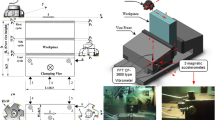Abstract
In the present work, cutting-force models of single-tooth and multi-teeth face-milling cutters were set up. Based on a spectrum analysis of cutting force, the vibration mechanism of a face-milling cutter of irregular pitch was investigated theoretically. The single-objective function and constraint conditions were derived. A general-purpose irregular-pitch face-milling cutter subsequently was designed and tested, and its performance was compared with that of a regular-pitch cutter. The experimental results showed that the irregular-pitch face-milling cutter not only reduces vibration and noise but also enhances surface-finish quality.
Similar content being viewed by others
References
J. Slavicek, The effect of irregular tooth pitch on stability of milling, Proceedings of the 6th Machine Tool Design and Research Conference (1965) 15–22.
H. Opitz, E. U. Dregger and H. Roese, Improvement of the dynamics stability of the milling process by irregular tooth pitch, Proceedings of the 7th Machine Tool Design and Research Conference (1966) 213–227.
P. Vanherek, Increasing milling machine productivity by use of cutter with non-constant cutting edge pitch, Proceedings of the 8th Machine Tool Design and Research Conference (1967) 947–960.
P. Doolan, M. S. Phadke and S. M. Wu, Computer design of vibration-free face milling cutter, Transactions of the ASME, Journal of Engineering for Industry, 97B(3) (1975) 925–930.
P. Doolan, F. A. Burney and S. M. Wu, Computer design of a multi-purpose minimum vibration face milling cutter, International Journal of Machine Tools Design & Research, 16 (1976) 187–192.
P. Doolan, M. S. Phadke and S. M. Wu, Computer design of minimum vibration face milling cutter using an improved cutting force model. Transactions of the ASME, Journal of Engineering for Industry, 98B(3) (1976) 807–810.
P. E. Gygax, Dynamics of single tooth milling, Annals of the CIRP, 28(1) (1979) 65–69.
P. E. Gygax, Experimental full cut milling dynamics, Annals of the CIRP, 29(1) (1980) 61–66.
R. Zhou, K. K. Wang, Modeling of cutting force pulsations in face milling, Annals of the CIRP, 32(1) (1983) 21–26.
Hui Li and Fengli Liu, Study of modern vibration-free facemilling cutters. Journal of Tangshan Institute of Technology, 16(4) (1994) 16–22.
S. A. Tobias, The vibration of vertical milling machines under test and working conditions, Proceedings Institution of Mechanical Engineers, 173 (1959) 474–483.
H. S. Kim and K. F. Ehmann, A cutting force model for face milling operations, International Journal Mechanical Tools & Manufacture, 33(5) (1993) 651–673.
J. Heikkala, Determining of cutting force components in face milling, Journal of Materials Processing Technology, 52(1) (1995) 1–8.
F. Gu, S. G. Kapoor and R. E. Devor, An enhanced cutting force model for face milling with variable cutter feed motion and complex workpiece geometry, International Journal of Manufacturing Science and Engineering, 119(4) (1997) 467–475.
J. Tlusty, A method of analysis of machine tool stability, Proceedings of the 6th Machine Tool Design and Research Conference (1965) 5–14.
Author information
Authors and Affiliations
Corresponding author
Additional information
This paper was recommended for publication in revised form by Associate Editor Eung Soo Shin
Hui Li received his B.S. in Mechanical Engineering from Hebei Polytechnic University, Hebei, China, in 1991. He received his M.S. in Mechanical Engineering from Harbin University of Science and Technology, Heilongjiang, China, in 1994, and his Ph.D. from Tianjin University’s School of Mechanical Engineering, Tianjin, China, in 2003. He was a postdoctoral researcher at Shijiazhuang Mechanical Engineering College from August 2003 to September 2005, and at Beijing Jiaotong University from March 2006 to December 2008. He is currently a professor of Mechanical Engineering at Shijiazhuang Institute of Railway Technology, China. His research and teaching interests include hybrid drive mechanisms, kinematics and dynamics of machinery, mechatronics, CAD/CAPP, and signal processing for machine health monitoring, diagnosis and prognosis. He is currently a senior member of the Chinese Society of Mechanical Engineering.
Rights and permissions
About this article
Cite this article
Li, H., Zheng, H. & Tang, L. Theoretical and experimental investigation of the effects of an irregular-pitch cutter on vibration in face-milling. J Mech Sci Technol 24, 2169–2174 (2010). https://doi.org/10.1007/s12206-010-0818-1
Received:
Revised:
Accepted:
Published:
Issue Date:
DOI: https://doi.org/10.1007/s12206-010-0818-1




